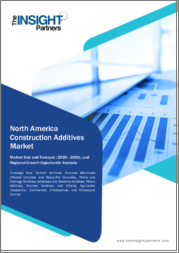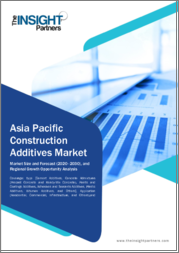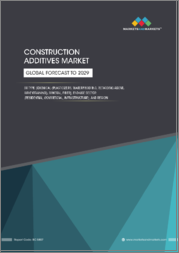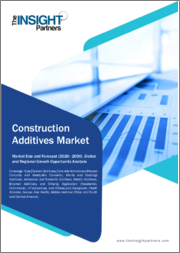
|
시장보고서
상품코드
1806174
건설용 첨가제 시장 : 제품 유형, 재료 유형, 형태, 위험 분류, 용도, 최종 용도, 유통 채널별 - 세계 예측(2025-2030년)Construction Additives Market by Product Type, Material Type, Form, Hazard Classification, Application, End Use, Distribution Channel - Global Forecast 2025-2030 |
||||||
건설용 첨가제 시장은 2024년에는 327억 3,000만 달러로 평가되었으며, 2025년에는 349억 5,000만 달러, CAGR 6.98%로 성장하여 2030년에는 490억 8,000만 달러에 달할 것으로 예측됩니다.
| 주요 시장 통계 | |
|---|---|
| 기준 연도 2024년 | 327억 3,000만 달러 |
| 추정 연도 2025년 | 349억 5,000만 달러 |
| 예측 연도 2030년 | 490억 8,000만 달러 |
| CAGR(%) | 6.98% |
현대 프로젝트의 효율성, 내구성 및 지속가능성을 촉진하는 혁신적인 배합으로 건설용 첨가제에 혁명을 일으켰습니다.
건설용 첨가제는 현대 시멘트와 아스팔트 배합의 핵심으로 등장하여 원자재를 인프라, 주거 및 상업 프로젝트의 진화하는 요구 사항을 충족하는 고성능 건축 솔루션으로 바꾸어 왔습니다. 지난 10년간 이러한 특수 화합물은 내구성 강화, 경화 시간 단축, 작업성 제어, 환경 스트레스에 대한 내성을 부여하는 데 필수적인 역할을 해왔습니다. 건설 업계가 지속가능성 목표, 순환 경제 원칙, 디지털 통합을 계속 받아들이면서 첨가제의 역할은 단순한 성능 향상제에서 기술 혁신과 효율성을 실현하는 것으로 확대되고 있습니다.
밸류체인을 형성하는 지속가능성과 규제 영향에 중점을 둔 건설용 첨가제의 변혁적 변화를 밝힙니다.
기술의 비약적인 발전, 엄격한 환경 규제, 도시화율의 증가로 인해 건설용 첨가제의 상황은 변혁적인 변화를 가져오고 있습니다. 예를 들어, 나노 물질을 주입한 첨단 화학제품은 고성능 콘크리트의 강도와 수명에 대한 벤치마크를 재정의하고 있으며, 디지털 시뮬레이션 도구는 배합 최적화를 가속화하고 실험실 배치에 대한 시행착오에 대한 의존도를 낮추고 있습니다. 동시에 주요 시장의 규제 기관은 휘발성 유기 화합물 및 수명주기 평가에 대한 보다 엄격한 기준을 도입하고 있으며, 공급업체는 포트폴리오를 재검토하고 친환경 원료에 대한 투자를 장려하고 있습니다.
2025년 미국 관세가 원자재 비용에 미치는 누적 영향에 대한 이해 공급 역학 및 경쟁 세계 기업들
미국이 2025년 주요 수입 원자재에 새로운 관세를 부과함에 따라 건설용 첨가제 제조업체의 공급망 역학이 크게 변화했습니다. 리그노설포네이트, 특수 폴리머, 성능 안료의 투입 비용은 수입의 여러 단계에서 적용되는 관세로 인해 상승하고 있습니다. 이에 대응하기 위해 주요 제조업체들은 조달 전략을 재검토하고 북미 공급업체로 조달을 전환하거나 멕시코와 캐나다에서 선택적으로 니어쇼어링을 실시하여 관세 부담을 줄이고 리드타임을 단축하고 있습니다. 이러한 전략적 조정을 통해 보다 예측 가능한 인바운드 물류를 제공하고, 원자재 파트너와의 긴밀한 협력 관계를 통해 장기적인 약속을 보장할 수 있게 되었습니다.
정확한 시장 파악을 위해 제품 소재 형태 위험 용도 최종 용도 및 유통 채널에 대한 주요 세분화 인사이트를 추출합니다.
시장 세분화에 대한 미묘한 이해는 용도 및 최종 사용 부문에 걸친 이질적인 요구 사항을 탐색하는 데 필수적입니다. 프리캐스트 콘크리트의 경화를 촉진하기 위한 촉진제나 고 유동성 자가 충전 믹스를 위한 초가소제로 배합을 조정할 경우, 요구되는 성능은 크게 달라집니다. 한편, 고온 환경에서는 수화 조절 첨가제가 중요한 역할을 하고, 추운 지역에서는 공기 포집제가 동결융해 저항성을 향상시킵니다. 방수제 및 지연제는 시멘트계 시스템의 기능을 더욱 확장하여 내구성과 습기 관리에 대한 중요한 요구 사항을 충족시킵니다.
아메리카, 유럽, 중동 및 아프리카, 아시아태평양의 전략적 성장 촉진요인, 과제 및 기회를 분석하여 주요 지역 인사이트를 제공합니다.
지역별 시장 역학은 북미의 건설 우선순위가 인프라 갱신, 기상 이변에 대한 복원력, 저탄소 기준의 주정부 조달 정책으로의 통합에 의해 추진되고 있음을 분명히 보여줍니다. 이에 따라 수명을 연장하고 유지보수 주기를 단축할 수 있는 고성능 혼화제에 대한 수요가 증가하고 있습니다. 반면, 유럽, 중동 및 아프리카는 도시화가 진행되는 신흥 경제국과 함께 환경 규제가 확립된 성숙한 시장이 모자이크 형태로 존재하고 있습니다. 서유럽 국가들은 그린 빌딩 인증에 중점을 두고 있으며, 바이오 기반 및 저 VOC 혼화제의 보급을 장려하고 있습니다. 한편, 중동 산유국 시장은 대규모 인프라 및 스마트 시티 계획에 자본을 배분하고 있으며, 빠른 경화 및 고강도 배합물에 대한 수요를 창출하고 있습니다.
세계 건설용 첨가제 시장 환경에서 리더십 역학을 정의하는 주요 기업 전략의 혁신과 협업의 주요 하이라이트
업계 주요 기업들은 경쟁력을 유지하고 혁신 주기를 가속화하기 위해 다양한 전략적 궤도를 추구하고 있습니다. 대형 화학 대기업은 세계 R&D 네트워크를 활용하여 독자적인 폴리머 블렌드 및 나노 강화 혼합물을 공동 개발하는 동시에 장비 제조업체와 파트너십을 맺고 주입 시스템 및 디지털 모니터링 기능을 통합하고 있습니다. 이와 함께 민첩한 전문 제조업체들은 식물 기반 배합을 전문으로 하거나 프리캐스트 모듈러 건설을 위한 턴키 혼화제 솔루션을 공급하는 등 차별화된 틈새시장을 개척하고 있습니다.
지속가능한 성장을 촉진하기 위한 실행 가능한 제안 수립 건설용 첨가제 분야의 경영 효율성 최적화 및 경쟁 우위 강화를 위한 실행 가능한 제안 수립
진화하는 상황을 효과적으로 극복하기 위해 업계 리더들은 지속가능성을 중시하는 제품 개발을 우선시하고, 지역 환경 규제에 부합하는 바이오 유래 및 저탄소 첨가제를 위한 연구 노력을 기울여야 합니다. 동시에 여러 지역의 공급업체와 유연한 공급 계약을 체결하여 관세의 영향과 물류의 혼란을 완화하고 고부가가치 원료의 연속성을 보장할 수 있습니다. 또한, IoT 지원 투약 장비와 클라우드 기반 품질 모니터링 플랫폼을 통합하여 제품의 일관성을 높이고, 폐기물을 줄이며, 투명성과 실시간 성능 데이터를 원하는 최종사용자와의 유대감을 강화할 수 있습니다.
견고하고 실용적인 인사이트를 보장하는 데이터 수집 검증 및 분석 방법 등 엄격한 조사 방법론에 대한 자세한 내용
이 분석의 기초는 2차 조사와 1차 조사의 탄탄한 조합에 있습니다. 먼저, 기술 잡지, 특허 출원, 규제 관련 간행물, 백서를 종합적으로 검토하여 새로운 화학제품, 환경 규제, 성능 벤치마킹에 대한 기본적인 이해를 확립하였습니다. 동시에 자체 데이터베이스에서 과거 원자재 가격 지수, 무역 흐름 통계, 특허 랜드스케이프 매핑을 수집했습니다.
부문 동향을 종합한 종합적인 결론 건설용 첨가제 이해관계자를 위한 전략적 의미와 향후 전망은 다음과 같습니다.
건설용 첨가제의 상황은 성능 최적화, 지속가능성 준수, 공급망 강인성이 교차하는 변곡점에 위치하고 있습니다. 변혁적 기술과 순환 경제의 원칙이 확산됨에 따라 배합업체와 건설업체 모두 전략을 재조정하고 새로운 화학제품, 디지털 투약 플랫폼, 공동 혁신 모델을 도입해야 합니다. 규제 압력과 관세 제도는 유연한 조달과 지역 내 생산능력의 중요성을 강조하고, 최종 용도의 세분화는 다양한 용도에 걸친 정밀 엔지니어링 솔루션의 필요성을 강조하고 있습니다.
목차
제1장 서문
제2장 조사 방법
제3장 주요 요약
제4장 시장 개요
제5장 시장 역학
제6장 시장 인사이트
- Porter's Five Forces 분석
- PESTEL 분석
제7장 미국 관세의 누적 영향 2025
제8장 건설용 첨가제 시장 : 제품 유형별
- 엑셀러레이터
- 공기 유입제
- 소포제
- 수분 제어 첨가제
- 이형제
- 지연제
- 고성능 감수제
- 방수제
제9장 건설용 첨가제 시장 : 소재 유형별
- 천연 혼화제
- 광물유계 약제
- 에멀전
- 퓨어 오일
- 식물 유래 약제
- 광물유계 약제
- 합성 혼화제
- 하이브리드
- 실리콘 기반
제10장 건설용 첨가제 시장 : 형태별
- 액체
- 수성
- 용제형
- 분말
제11장 건설용 첨가제 시장 : 위험 분류별
- 라벨 프리
- 라벨 부착
제12장 건설용 첨가제 시장 : 용도별
- 아스팔트 생산
- 오토클레이브 양생 기포 콘크리트(AAC) 제조
- 그라우트
- 석고
- 프리캐스트 콘크리트
- 드라이 캐스트
- 웨트 캐스트
제13장 건설용 첨가제 시장 : 최종 용도별
- 상업용
- 산업
- 인프라
- 교량
- 댐
- 고속도로
- 주거용
제14장 건설용 첨가제 시장 : 유통 채널별
- 오프라인
- 직접 판매
- 도매업체
- 온라인
- 기업 웹사이트
- 마켓플레이스
제15장 아메리카의 건설용 첨가제 시장
- 미국
- 캐나다
- 멕시코
- 브라질
- 아르헨티나
제16장 유럽, 중동 및 아프리카의 건설용 첨가제 시장
- 영국
- 독일
- 프랑스
- 러시아
- 이탈리아
- 스페인
- 아랍에미리트
- 사우디아라비아
- 남아프리카공화국
- 덴마크
- 네덜란드
- 카타르
- 핀란드
- 스웨덴
- 나이지리아
- 이집트
- 튀르키예
- 이스라엘
- 노르웨이
- 폴란드
- 스위스
제17장 아시아태평양의 건설용 첨가제 시장
- 중국
- 인도
- 일본
- 호주
- 한국
- 인도네시아
- 태국
- 필리핀
- 말레이시아
- 싱가포르
- 베트남
- 대만
제18장 경쟁 구도
- 시장 점유율 분석, 2024
- FPNV 포지셔닝 매트릭스, 2024
- 경쟁 분석
- Clariant AG
- BASF SE
- Birla Corporation Limited
- Chryso S.A.S. by Saint-Gobain
- ADO Additives Mfg Pvt. Ltd.
- Concrete Additives & Chemicals Pvt. Ltd.
- Denka Company Limited
- Emsland Group
- Fosroc International Ltd.
- Hycrete, Inc.
- Innovation Concrete Laboratory Kft.
- LEVACO Chemicals GmbH
- Mapei S.p.A.
- Mathiesen Group
- Nouryon Chemicals Holding B.V.
- Pidilite Industries Ltd.
- RPM International Inc.
- Sika AG
- Solvay S.A.
- Synthomer PLC
- The Dow Chemical Company
- Thermax Limited
- Tolsa S.A.
- USG Corporation by Knauf Group
- W. R. Grace & Company by Standard Industries
- Ecoratio
제19장 리서치 AI
제20장 리서치 통계
제21장 리서치 컨택트
제22장 리서치 기사
제23장 부록
KSM 25.09.12The Construction Additives Market was valued at USD 32.73 billion in 2024 and is projected to grow to USD 34.95 billion in 2025, with a CAGR of 6.98%, reaching USD 49.08 billion by 2030.
| KEY MARKET STATISTICS | |
|---|---|
| Base Year [2024] | USD 32.73 billion |
| Estimated Year [2025] | USD 34.95 billion |
| Forecast Year [2030] | USD 49.08 billion |
| CAGR (%) | 6.98% |
Revolutionizing Construction Additives Through Innovative Formulations That Drive Efficiency Durability and Sustainability in Modern Projects
Construction additives have emerged as the cornerstone of modern cementitious and asphalt formulations, transforming raw materials into high-performance building solutions that meet the evolving demands of infrastructure, residential, and commercial projects. Over the past decade, these specialized chemical compounds have become integral to enhancing durability, accelerating curing times, controlling workability, and imparting resistance to environmental stresses. As the construction industry continues to embrace sustainability objectives, circular economy principles, and digital integration, the role of additives has expanded beyond simple performance enhancers to enablers of innovation and efficiency.
Against a backdrop of tightening regulations on carbon emissions, volatile raw material prices, and shifting end-use requirements, stakeholders across the value chain are reassessing formulation strategies and supplier partnerships. Contractors, architects, and engineers are increasingly specifying admixtures that not only deliver predictable mechanical properties but also contribute to green building certifications and lifecycle cost reductions. In parallel, additive manufacturers are investing heavily in research and development to pioneer bio-based and low-carbon alternatives, reinforcing their value proposition in an environment where environmental accountability and cost optimization go hand in hand.
Unveiling Transformative Shifts in Construction Additives Emphasizing Technological Advances Sustainability and Regulatory Influences Reshaping the Value Chain
Technological breakthroughs, stringent environmental mandates, and rising urbanization rates have collectively sparked transformative shifts within the construction additives landscape. Advanced chemistries infused with nanomaterials, for instance, are redefining strength and longevity benchmarks for high-performance concrete, while digital simulation tools are accelerating formulation optimization and reducing reliance on trial-and-error lab batches. Concurrently, regulatory bodies across major markets have introduced more rigorous standards around volatile organic compounds and lifecycle assessments, prompting suppliers to reformulate their portfolios and invest in eco-friendly raw materials.
In parallel, the growing emphasis on circular economy models has led to the integration of recycled polymers, industrial by-products, and bio-derivatives into admixture designs. These alternative sources not only alleviate landfill pressures but also mitigate supply chain disruptions, thereby reinforcing resilience against geopolitical events and shipping delays. As stakeholders embrace data analytics and predictive maintenance platforms, connectivity-driven additive dosing systems are gaining traction, enabling real-time quality control and resource efficiency on project sites. Together, these advancements are reshaping the value proposition of additives from simple dosing aids to strategic enablers of project performance, sustainability compliance, and cost stewardship.
Understanding the Cumulative Impact of United States Tariffs in 2025 on Raw Material Costs Supply Dynamics and Competitive Positioning Global Players
The imposition of new tariffs by the United States in 2025 on key imported raw materials has significantly altered supply chain dynamics for construction additive producers. Input costs for lignosulfonates, specialty polymers, and performance pigments have risen due to duties applied at various stages of importation. In response, leading manufacturers have revisited sourcing strategies, shifting procurement toward North American suppliers or selectively near-shoring operations in Mexico and Canada to mitigate duty burdens and reduce lead times. These strategic adjustments have provided more predictable inbound logistics and fostered closer collaboration with raw material partners to secure long-term commitments.
Moreover, tariff-driven disruptions have spurred investment in domestic capacity expansion and alternative feedstock research. Collaborative ventures between additive formulators and chemical producers are underway to develop home-grown substitutes that align with performance requirements and environmental guidelines. In anticipation of ongoing trade volatility, stakeholders are also diversifying procurement contracts, incorporating flexible volume clauses and dual-sourcing agreements to sustain production continuity. As a result, the additive ecosystem is witnessing a paradigm shift toward resilient, regionally balanced supply chains that prioritize strategic partnerships, onshore capabilities, and regulatory compliance over single-source dependency.
Extracting Key Segmentation Insights Across Product Material Form Hazard Application End Use and Distribution Channels for Precision Market Understanding
A nuanced understanding of market segmentation is essential to navigate the heterogeneous needs across applications and end-use sectors. Performance requirements vary widely when formulations are tailored as accelerators to expedite curing in precast concrete or as superplasticizers for high-flow self-compacting mixes. Meanwhile, hydration control additives play a pivotal role in high-temperature environments, while air entraining agents improve freeze-thaw resistance in cold-climate regions. Waterproofing agents and retarders further broaden the capabilities of cementitious systems, addressing critical demands for durability and moisture management.
Material type segmentation reveals a clear dichotomy between natural admixtures and synthetic alternatives. Mineral oil-based agents, available in both emulsions and pure oils, offer cost-effective moisture control, while plant-based agents have gained traction in LEED-oriented projects. On the other hand, hybrid polymers and silicone-based synthetic admixtures deliver superior water reduction and workability. Form preferences also diverge, with aqueous and solvent-based liquids favored for ease of dosing, while powder forms are prized for storage stability and transport efficiency.
In addition, hazard classification influences procurement decisions, as label-free additives simplify regulatory compliance and reduce handling complexities on site, whereas labelled formulations offer explicit safety parameters for specialized environments. Application-driven segmentation further highlights distinct performance matrices for asphalt production, grout, plaster, and autoclaved aerated concrete, with precast concrete splitting into drycast processes for modular manufacturing and wetcast methods for complex architectural precast elements. End-use analyses underscore that commercial and industrial segments demand high-strength, rapid-setting morphologies, infrastructure projects such as bridges, dams, and highways require extreme durability under cyclical loading, and residential construction leans toward cost-effective, user-friendly solutions. Finally, distribution channel preferences range from direct sales or distributor networks in offline models to company websites and online marketplaces, reflecting a broader shift toward digital procurement platforms that enhance transparency and speed of fulfillment.
Unlocking Key Regional Insights by Analyzing Strategic Growth Drivers Challenges and Opportunities in the Americas Europe Middle East Africa and Asia Pacific
Regional market dynamics underscore that North American construction priorities are driven by infrastructure renewal, resilience against extreme weather events, and the integration of low-carbon standards into state procurement policies. This emphasis has elevated demand for high-performance admixtures capable of extending service life and reducing maintenance cycles. In contrast, the Europe Middle East & Africa region presents a mosaic of mature markets with established environmental regulations alongside emerging economies with growing urbanization. Countries in Western Europe focus heavily on green building certifications, prompting proliferation of bio-based and low-VOC admixtures, whereas oil-producing markets in the Middle East allocate capital toward large-scale infrastructure and smart city initiatives, creating demand for rapid-curing, high-strength formulations.
Meanwhile, Asia Pacific remains a high-growth arena fueled by robust construction pipelines in China, India, and Southeast Asia. Accelerated urbanization, government-backed affordable housing projects, and elevated highway and rail investments are driving volume growth. At the same time, regulatory scrutiny on particulate emissions and water usage has spurred local producers to innovate eco-sensitive chemistries and align with circular water reuse programs. Together, these regional narratives reflect the importance of aligning additive performance characteristics with localized project specifications, environmental mandates, and distribution infrastructures.
Highlighting Key Company Strategies Innovations and Collaborations That Define Leadership Dynamics in the Global Construction Additives Market Landscape
Industry leaders are pursuing diverse strategic trajectories to maintain competitive edge and accelerate innovation cycles. Major chemical conglomerates are leveraging global R&D networks to co-develop proprietary polymer blends and nano-reinforced admixtures, while simultaneously forging partnerships with equipment manufacturers to integrate dosing systems and digital monitoring capabilities. In parallel, nimble specialty producers are carving out differentiated niches by focusing exclusively on plant-based formulations or supplying turnkey admixture solutions for precast modular construction.
Collaborative alliances between additive manufacturers and cement producers are also taking shape, pooling resources to optimize cement-additive synergies and reduce overall carbon footprints. These partnerships often encompass joint pilot facilities where formulations undergo real-world performance evaluations before large-scale roll-out. At the same time, several organizations are expanding their footprint in emerging markets through targeted acquisitions of local specialty chemical players, thereby securing distribution networks and accelerating time to market. Complementing these outward-facing strategies are robust internal initiatives centered on open innovation platforms, where cross-functional teams harness data analytics and high-throughput experimentation to streamline formulation development and shorten commercialization timelines.
Formulating Actionable Recommendations to Drive Sustainable Growth Optimize Operational Efficiency and Strengthen Competitive Positioning in Construction Additives
To navigate the evolving terrain effectively, industry leaders should prioritize sustainability-driven product development, channeling research efforts toward bio-derived and low-carbon additives that align with regional environmental mandates. At the same time, securing flexible supply contracts with multiple regional suppliers will help mitigate tariff impacts and logistics disruptions, ensuring continuity of high-value raw materials. Furthermore, integrating IoT-enabled dosing equipment and cloud-based quality monitoring platforms can elevate product consistency, reduce waste, and foster stronger bonds with end-users who demand transparency and real-time performance data.
Collaborative engagement with construction firms, cement producers, and regulatory bodies is also essential. By forming joint innovation consortia, stakeholders can co-create standard testing protocols, expedite approval processes, and cultivate best practices that benefit the entire ecosystem. In parallel, investing in upskilling programs for sales and technical personnel will empower teams to demonstrate value propositions effectively, bridging knowledge gaps and reinforcing customer trust. Ultimately, those who implement a holistic strategy encompassing sustainable innovation, supply chain resilience, digital integration, and stakeholder partnerships will be best positioned to capture growth opportunities and drive long-term value.
Detailing the Rigorous Research Methodology Employed Including Data Collection Validation and Analytical Techniques Ensuring Robust and Actionable Insights
The foundation of this analysis rests upon a robust combination of secondary research and primary validation. Initially, a comprehensive review of technical journals, patent filings, regulatory publications, and white papers established a baseline understanding of emerging chemistries, environmental regulations, and performance benchmarks. Concurrently, proprietary databases were mined for historical raw material pricing indices, trade flow statistics, and patent landscape mappings.
Primary insights were subsequently gathered through structured interviews with formulation scientists, procurement leaders, and industry consultants, ensuring nuanced perspectives on supply chain resilience, regional adoption trends, and innovation roadblocks. Data triangulation techniques were applied to reconcile any discrepancies between secondary sources and interview findings, bolstering the validity of thematic conclusions. Finally, quantitative analyses, including cluster segmentation and scenario modeling, were leveraged to identify optimal formulation strategies under varying regulatory and cost environments, while qualitative frameworks helped elaborate strategic imperatives for different stakeholder groups.
Delivering a Comprehensive Conclusion That Synthesizes Sector Trends Strategic Implications and Future Outlook for Stakeholders in Construction Additives
The construction additives landscape is poised at an inflection point where performance optimization, sustainability compliance, and supply chain resilience intersect. As transformative technologies and circular economy principles gain traction, formulators and contractors alike will need to recalibrate strategies, embracing novel chemistries, digital dosing platforms, and collaborative innovation models. Regulatory pressures and tariff regimes have underscored the importance of flexible sourcing and in-region production capabilities, while end-use segmentation highlights the need for precision-engineered solutions across diverse applications.
Stakeholders who integrate environmental stewardship with proactive partnerships and cutting-edge digital tools will find themselves at the forefront of a rapidly evolving ecosystem. By aligning product portfolios with localized mandates and project specifications, additive providers can address critical performance gaps and deliver unrivaled value. This synthesis of market dynamics, strategic imperatives, and regional narratives provides a comprehensive framework for decision-makers seeking to capitalize on the next wave of growth in construction additives.
Table of Contents
1. Preface
- 1.1. Objectives of the Study
- 1.2. Market Segmentation & Coverage
- 1.3. Years Considered for the Study
- 1.4. Currency & Pricing
- 1.5. Language
- 1.6. Stakeholders
2. Research Methodology
- 2.1. Define: Research Objective
- 2.2. Determine: Research Design
- 2.3. Prepare: Research Instrument
- 2.4. Collect: Data Source
- 2.5. Analyze: Data Interpretation
- 2.6. Formulate: Data Verification
- 2.7. Publish: Research Report
- 2.8. Repeat: Report Update
3. Executive Summary
4. Market Overview
- 4.1. Introduction
- 4.2. Market Sizing & Forecasting
5. Market Dynamics
- 5.1. Rising adoption of silica fume and metakaolin blends for enhanced concrete durability in marine environments
- 5.2. Integration of self-healing microcapsule technology in cementitious coatings to prevent crack propagation under cyclic loading
- 5.3. Development of bio-based polymer admixtures sourced from agricultural waste for sustainable construction materials
- 5.4. Increasing use of graphene and carbon nanotube additives for high-performance concrete with improved tensile strength
- 5.5. Growth of 3D printed concrete formulations optimized with rheology-modifying superplasticizers and shrinkage reducers
- 5.6. Implementation of carbon capture and utilization additives in cement production to achieve low-carbon footprint building materials
- 5.7. Application of AI-driven predictive modeling in additive formulation to tailor performance properties for specific infrastructure projects
- 5.8. Emergence of calcium formate and lithium-based accelerators for cold-weather concrete placement
- 5.9. Use of nanostructured magnesium oxide hydrate for controlling alkali silica reaction in high-alkali aggregates
- 5.10. Adoption of advanced shrinkage-compensating expansive agents in mass concrete applications
6. Market Insights
- 6.1. Porter's Five Forces Analysis
- 6.2. PESTLE Analysis
7. Cumulative Impact of United States Tariffs 2025
8. Construction Additives Market, by Product Type
- 8.1. Introduction
- 8.2. Accelerators
- 8.3. Air Entraining Agents
- 8.4. Defoamers
- 8.5. Hydration Control Additives
- 8.6. Release Agents
- 8.7. Retarders
- 8.8. Superplasticizers
- 8.9. Waterproofing Agents
9. Construction Additives Market, by Material Type
- 9.1. Introduction
- 9.2. Natural Admixtures
- 9.2.1. Mineral Oil-based Agents
- 9.2.1.1. Emulsions
- 9.2.1.2. Pure Oils
- 9.2.2. Plant-based Agents
- 9.2.1. Mineral Oil-based Agents
- 9.3. Synthetic Admixtures
- 9.3.1. Hybrid
- 9.3.2. Silicone-based
10. Construction Additives Market, by Form
- 10.1. Introduction
- 10.2. Liquid
- 10.2.1. Aqueous
- 10.2.2. Solvent Based
- 10.3. Powder
11. Construction Additives Market, by Hazard Classification
- 11.1. Introduction
- 11.2. Label-free
- 11.3. Labelled
12. Construction Additives Market, by Application
- 12.1. Introduction
- 12.2. Asphalt Production
- 12.3. Autoclaved Aerated Concrete (AAC) Production
- 12.4. Grout
- 12.5. Plaster
- 12.6. Precast Concrete
- 12.6.1. Drycast
- 12.6.2. Wetcast
13. Construction Additives Market, by End Use
- 13.1. Introduction
- 13.2. Commercial
- 13.3. Industrial
- 13.4. Infrastructure
- 13.4.1. Bridges
- 13.4.2. Dams
- 13.4.3. Highways
- 13.5. Residential
14. Construction Additives Market, by Distribution Channel
- 14.1. Introduction
- 14.2. Offline
- 14.2.1. Direct Sales
- 14.2.2. Distributor
- 14.3. Online
- 14.3.1. Company Website
- 14.3.2. Marketplaces
15. Americas Construction Additives Market
- 15.1. Introduction
- 15.2. United States
- 15.3. Canada
- 15.4. Mexico
- 15.5. Brazil
- 15.6. Argentina
16. Europe, Middle East & Africa Construction Additives Market
- 16.1. Introduction
- 16.2. United Kingdom
- 16.3. Germany
- 16.4. France
- 16.5. Russia
- 16.6. Italy
- 16.7. Spain
- 16.8. United Arab Emirates
- 16.9. Saudi Arabia
- 16.10. South Africa
- 16.11. Denmark
- 16.12. Netherlands
- 16.13. Qatar
- 16.14. Finland
- 16.15. Sweden
- 16.16. Nigeria
- 16.17. Egypt
- 16.18. Turkey
- 16.19. Israel
- 16.20. Norway
- 16.21. Poland
- 16.22. Switzerland
17. Asia-Pacific Construction Additives Market
- 17.1. Introduction
- 17.2. China
- 17.3. India
- 17.4. Japan
- 17.5. Australia
- 17.6. South Korea
- 17.7. Indonesia
- 17.8. Thailand
- 17.9. Philippines
- 17.10. Malaysia
- 17.11. Singapore
- 17.12. Vietnam
- 17.13. Taiwan
18. Competitive Landscape
- 18.1. Market Share Analysis, 2024
- 18.2. FPNV Positioning Matrix, 2024
- 18.3. Competitive Analysis
- 18.3.1. Clariant AG
- 18.3.2. BASF SE
- 18.3.3. Birla Corporation Limited
- 18.3.4. Chryso S.A.S. by Saint-Gobain
- 18.3.5. ADO Additives Mfg Pvt. Ltd.
- 18.3.6. Concrete Additives & Chemicals Pvt. Ltd.
- 18.3.7. Denka Company Limited
- 18.3.8. Emsland Group
- 18.3.9. Fosroc International Ltd.
- 18.3.10. Hycrete, Inc.
- 18.3.11. Innovation Concrete Laboratory Kft.
- 18.3.12. LEVACO Chemicals GmbH
- 18.3.13. Mapei S.p.A.
- 18.3.14. Mathiesen Group
- 18.3.15. Nouryon Chemicals Holding B.V.
- 18.3.16. Pidilite Industries Ltd.
- 18.3.17. RPM International Inc.
- 18.3.18. Sika AG
- 18.3.19. Solvay S.A.
- 18.3.20. Synthomer PLC
- 18.3.21. The Dow Chemical Company
- 18.3.22. Thermax Limited
- 18.3.23. Tolsa S.A.
- 18.3.24. USG Corporation by Knauf Group
- 18.3.25. W. R. Grace & Company by Standard Industries
- 18.3.26. Ecoratio



















